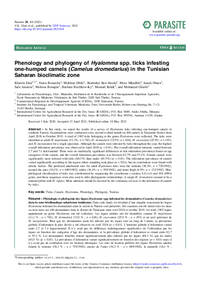Phenology and phylogeny of Hyalomma spp. ticks infesting one-humped camels (Camelus dromedarius) in the Tunisian Saharan bioclimatic zone

Authors:
In this study, we report the results of a survey of Hyalomma ticks infesting one-humped camels in southern Tunisia. Examinations were conducted every second or third month on 406 camels in Tataouine district from April 2018 to October 2019. A total of 1902 ticks belonging to the genus Hyalomma were collected. The ticks were identified as adult H. impeltatum (41.1%; n = 782), H. dromedarii (32.9%; n = 626), H. excavatum (25.9%; n = 493), and [H. marginatum for a single specimen. Although the camels were infested by ticks throughout the year, the highest overall infestation prevalence was observed in April 2018 (p < 0.01). The overall infestation intensity varied between 2.7 and 7.4 ticks/animal. There were no statistically significant differences in tick infestation prevalence based on age categories of the camels, and the overall infestation prevalence was between 82.7% and 97.4%. Female camels were significantly more infested with ticks (88.3%) than males (65.5%) (p < 0.01). The infestation prevalence of camels varied significantly according to the region where sampling took place (p < 0.01), but no correlations were found with abiotic factors. The preferred attachment sites for adult Hyalomma ticks were the sternum (38.3%; n = 729/1902), around the anus (36.2%; n = 689/1902), udder (18.4%; n = 350/1902), and inner thigh (6.9%; n = 132/1902). Morphological classification of ticks was corroborated by sequencing the cytochrome c oxidase I (Cox1) and 16S rDNA genes, and these sequences were also used to infer phylogenetic relationships. A single H. dromedarii seemed to be a natural hybrid with H. rufipes. More attention should be devoted by the veterinary services to the infestation of camels by ticks.
